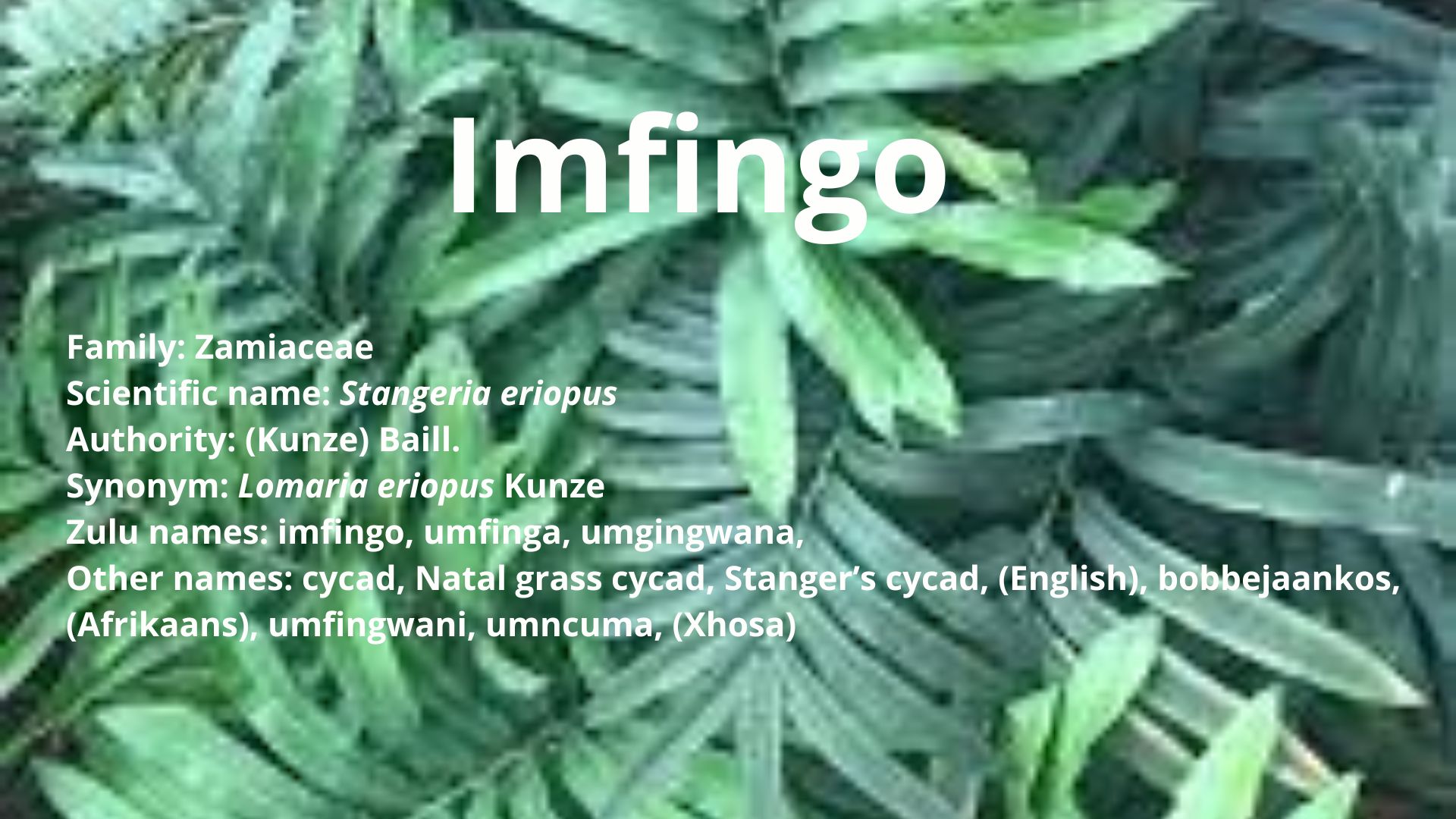Family: Zamiaceae
Scientific name: Stangeria eriopus
Authority: (Kunze) Baill.
Synonym: Lomaria eriopus Kunze
Zulu names: imfingo, umfinga, umgingwana,
Other names: cycad, Natal grass cycad, Stanger’s cycad, (English), bobbejaankos, (Afrikaans), umfingwani, umncuma, (Xhosa)
Description: S. eriopus is a slow growing perennial evergreen cycad that grows in grassland and forest habitats. It has large fern-like leaves, carrot shaped tubers, and egg-like yellowish brown cones, containing red seeds.
This cycad is endemic to the east coast of South Africa.
Uses:
- The fruits are used to make a penis-sheath.
- The plant is used as a sprinkling protective charm to prevent witches from entering the homestead.
- The plant is burnt and the ash is used as a protective charm for warring travellers.
- The roots are used to make an infusion that is taken as an emetic for cleansing and protection against harmful spirits.
- The roots are used to dispel bad dreams.
- The roots are burnt, powdered, and snuffed to treat headache.
- The plant is used to induce vomiting in children who have eaten something poisonous.
- The roots are worn by mothers with young infants as a protective charm.
- The plant is worn as a charm around the waist as a protective charm to drive away evil spirits.
- The root decoction is administered as an emetic to treat sharp internal body pains.
- The roots are used as a purgative for flatulence.
- The root decoction is administered by steaming.
- The root decoction is a tonic that is administered orally.
- The roots are used for painful bones.
- The plant is used to reduce high blood pressure in adults.
- The plant is used to treat congestion in infants.
- The plant is used to treat fits.
- The plant is used to get rid of internal parasites in cattle.
References and further reading:
- Alcock, P.G., The aurora australis (or the southern lights) in KwaZulu Natal. (1855–2011).
- Balogun, F.O. and Ashafa, A.O.T., 2019. A review of plants used in South African traditional medicine for the management and treatment of hypertension. Planta medica, 85(04), pp.312-334.
- Batten, A. and Bokelmann, H., 1966. Wild flowers of the eastern Cape Province.
- Broster, J., 1982. Amagqirha-Religion. Magic and Medicine in Transkei. Via Africa, Cape Town.
- Cunningham, A.B., 1988. An investigation of the herbal medicine trade in Natal/KwaZulu. Institute of Natural Resources Investigative Report Issue 29. Institute of Natural Resources, Pietermaritzburg.
- Doke, C.M. and Vilakazi, B.W., 1972. Zulu-English dictionary, second edition. Witwatersrand University Press, Johannesburg.
- Gerstner, J., 1938. A preliminary checklist Zulu names of plants with short notes. Bantu Studies.
- Hutchings, A., Scott, A.H., Lewis, G. and Cunningham, A., 1996. Zulu medicinal plants. Natal University Press, Pietermaritzburg.
- Mhlongo, L.S. and Van Wyk, B.E., 2019. Zulu medicinal ethnobotany: New records from the Amandawe area of KwaZulu-Natal, South Africa. South African Journal of Botany, 122, pp.266-290.
- Ndhlala, A.R., Stafford, G.I., Finnie, J.F. and Van Staden, J., 2011. Commercial herbal preparations in KwaZulu-Natal, South Africa: The urban face of traditional medicine. South African Journal of Botany, 77(4), pp.830-843.
- Osborne, R., Grove, A., Oh, P., Mabry, T.J., Ng, J.C. and Seawright, A.A., 1994. The magical and medicinal usage of Stangeria eriopus in South Africa. Journal of ethnopharmacology, 43(2), pp.67-72.
- Pooley, E., 2006. Forest plants in the forest and in the garden: Popular guides to the biomes of South Africa. The Flora Publication Trust, South Africa.
- Van Wyk, B.E. and Gericke, N., 2000. People’s plants. A guide to useful plants of southern Africa. Briza Publications, Pretoria.
- Watt, J.M. and Breyer-Brandwijk, M.G., 1962. Medicinal and poisonous plants of southern and eastern Africa, second edition. Livingstone, London.
- Williams, V.L., Balkwill, K. and Witkowski, E.T.F., 2001. A lexicon of plants traded in the Witwatersrand umuthi shops, South Africa. Bothalia, 31(1), pp.71-98.

